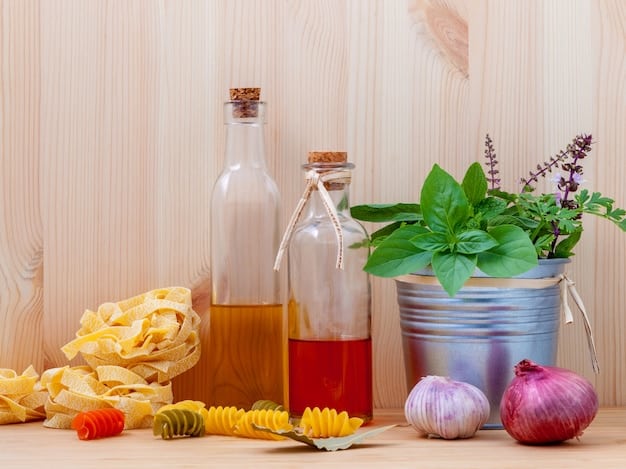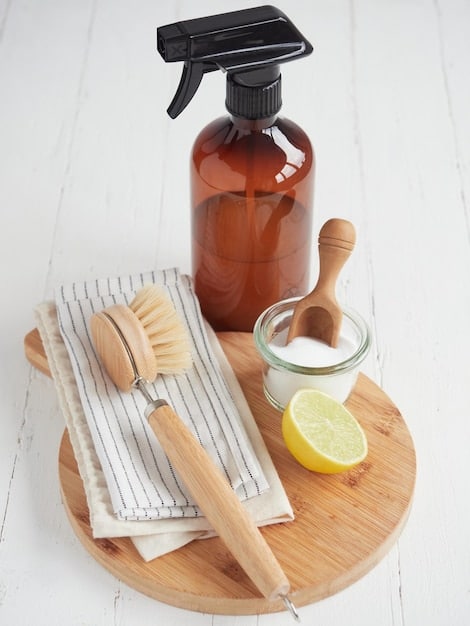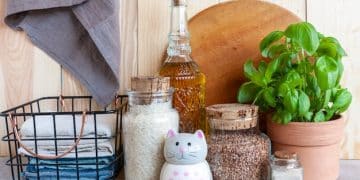Sustainable Cleaning: Reduce Chemical Exposure at Home

Choosing sustainable cleaning products is a pivotal step towards minimizing chemical exposure in your home, safeguarding both family health and environmental well-being through non-toxic, eco-friendly alternatives.
Embarking on a journey to understand How to Choose Sustainable Cleaning Products and Reduce Chemical Exposure? is more than a trend; it is a fundamental shift towards a healthier lifestyle and a more responsible stewardship of our planet. This guide delves into the essence of sustainable cleaning, providing actionable insights to transform your home into a sanctuary free from harsh chemicals.
The Imperative of Sustainable Cleaning
The transition to sustainable cleaning is not merely a choice but an urgent necessity. Conventional cleaning products, laden with an array of synthetic chemicals, pose significant risks. These risks extend beyond immediate skin irritation or respiratory issues, often contributing to long-term health complications and widespread environmental pollution. Understanding the pervasive impact of these chemicals is the first step towards embracing a healthier, more sustainable approach.
Many traditional cleaners contain volatile organic compounds (VOCs), phthalates, and phosphates, all of which contribute to indoor air pollution and can exacerbate allergies and asthma. While these products promise sparkling clean surfaces, their environmental footprint is often overlooked. The manufacturing processes consume vast amounts of energy and resources, and their disposal can contaminate water systems, harming aquatic life and ecosystems.
Unveiling the Hidden Dangers
Identifying the harmful ingredients in conventional cleaning products is crucial for making informed choices. Consumers often encounter complex chemical names on product labels, making it difficult to discern safety. Common culprits include:
- Ammonia: A respiratory irritant, often found in glass cleaners.
- Chlorine Bleach: Known for its strong disinfectant properties but corrosive and highly toxic if ingested or mixed with other chemicals.
- Phthalates: Often used in fragranced products, linked to endocrine disruption.
- Phosphates: Contributes to water pollution, promoting algal blooms that deplete aquatic oxygen.
These chemicals, while effective at cleaning, leave behind residues that can continue to off-gas into the air or be absorbed through skin contact. Over time, chronic exposure can accumulate, leading to a myriad of health problems from mild sensitivities to more severe conditions.
Environmental Ramifications
The cycle of chemical contamination does not end in your home. Once rinsed down the drain, these substances enter our wastewater systems. While treatment plants remove some pollutants, many persistent chemicals bypass these processes, eventually making their way into rivers, lakes, and oceans. This contributes to water body eutrophication, marine life endangerment, and broader ecological imbalances.
Furthermore, the packaging of conventional cleaning products, typically made from virgin plastics, contributes significantly to landfill waste. The sheer volume of single-use plastic containers is a pressing concern for environmentalists and a stark reminder of the linear economy we currently operate within. Embracing sustainable options means addressing not only the ingredients but also the packaging lifecycle.
The shift to sustainable cleaning is a holistic one, encompassing product ingredients, packaging, and manufacturing practices. It acknowledges the interconnectedness of human health and environmental integrity, advocating for choices that benefit both in the long run.
Decoding Eco-Labels and Certifications
Navigating the world of eco-friendly products can be perplexing, given the proliferation of green marketing claims. Understanding eco-labels and certifications is paramount for consumers seeking genuine sustainable solutions. These labels serve as verifiable assurances that a product meets specific environmental and health standards, differentiating truly green options from those engaging in “greenwashing.”
Various organizations and government bodies have established rigorous criteria for sustainable products, evaluating aspects from ingredient sourcing and manufacturing processes to packaging and end-of-life disposal. A certified eco-label indicates that a product has undergone independent verification, providing a transparent and trustworthy guide for consumers.
Key Certifications to Look For
Several reputable certifications exist, each with its own focus and criteria. Familiarizing yourself with these can significantly simplify your shopping experience:
- EPA Safer Choice: This U.S. Environmental Protection Agency program certifies products formulated with ingredients that are safer for human health and the environment. Products bearing this label undergo a thorough review of every ingredient.
- Green Seal: An independent non-profit organization that certifies products and services meeting stringent environmental leadership standards, including reduced toxicity, biodegradability, and sustainable packaging.
- ECOS logo (for ECOS products): While specific to the ECOS brand, their products are often highly regarded for plant-derived ingredients and commitment to environmental stewardship.
Other international labels like Ecocert (Europe) or Nordic Swan Ecolabel (Scandinavia) also signify high environmental performance. When you see these labels, it suggests that the product has been vetted by an impartial third party, adhering to a predefined set of ecological and health standards.
Beyond the Label: Critical Questions to Ask
While eco-labels are beneficial, they are not the sole determinant of sustainability. A truly informed consumer looks beyond the immediate certification to consider broader aspects of a product’s lifecycle. Asking critical questions can reveal the genuine commitment of a brand to sustainability.
Consider the company’s overall environmental policies. Do they prioritize renewable energy in manufacturing? Do they have programs for reducing waste? How transparent are they about their supply chain? A company committed to sustainability often shares information about their practices, from sourcing raw materials to product distribution.
Furthermore, think about the packaging. Is it recyclable, compostable, or made from recycled content? Does the company offer refill options to minimize single-use plastics? These details, though sometimes overlooked, play a significant role in a product’s overall environmental impact. Opting for concentrated formulas or products sold in bulk can further reduce packaging waste and shipping emissions.
Being an informed consumer means not just reading labels, but understanding the broader implications of your purchasing decisions. It’s about supporting brands that align with your values and contribute positively to both global and local environmental health.
DIY Sustainable Cleaning Solutions
For those looking to take sustainability into their own hands, creating DIY cleaning solutions is an excellent and cost-effective approach. Many common household ingredients pack a powerful cleaning punch without the need for harsh chemicals or excessive packaging. This method empowers individuals to control exactly what goes into their cleaning products, ensuring transparency and minimizing exposure to unknown substances.
Using simple, natural ingredients like vinegar, baking soda, lemon juice, and essential oils can tackle most household cleaning tasks effectively. These ingredients are readily available, inexpensive, and pose minimal risk to human health or the environment when used correctly. Moreover, by mixing your own solutions, you contribute less to plastic waste, fostering a more circular economy within your home.
Essential Ingredients and Their Uses
The foundation of any effective DIY cleaning regimen lies in a few versatile ingredients. Understanding their properties allows for targeted cleaning solutions:
- White Vinegar: A powerful disinfectant and degreaser due to its acetic acid content. Excellent for glass, surfaces, and descaling.
- Baking Soda (Sodium Bicarbonate): A mild abrasive and deodorizer, perfect for scrubbing sinks, tubs, and absorbing odors.
- Lemon Juice: Contains citric acid, making it a natural bleaching agent and deodorizer. Good for removing stains and adding a fresh scent.
- Essential Oils (e.g., Tea Tree, Lavender, Lemon): Provide natural fragrance and offer antimicrobial properties.
Mixing these components in varying proportions can create solutions for almost any cleaning challenge. For example, a mixture of vinegar and water can create an all-purpose cleaner, while baking soda and a little water form a paste for tough scrubbing jobs. The beauty of DIY solutions lies in their simplicity and adaptability.

Recipes for a Greener Home
Here are a few basic recipes to get you started on your DIY cleaning journey:
All-Purpose Cleaner:
1 part white vinegar
1 part water
10-15 drops of essential oil (optional, for scent like lemon or lavender)
Combine in a spray bottle. Use on countertops, sinks, and most surfaces. Avoid using on natural stone as vinegar can etch it.
Scouring Paste:
½ cup baking soda
Enough water to form a paste (start with 1-2 tablespoons)
Mix and apply to stubborn grime in sinks, tubs, or ovens. Let sit for a few minutes before scrubbing and rinsing.
Glass Cleaner:
¼ cup white vinegar
¼ cup rubbing alcohol (optional, for streak-free shine)
1 tablespoon cornstarch (helps prevent streaks)
2 cups water
Mix well in a spray bottle. Spray on windows and mirrors, then wipe with a microfiber cloth or crumpled newspaper for a streak-free finish.
These recipes are merely starting points. Experimentation with different essential oils and slight adjustments to proportions can customize them to your specific needs and preferences. The move towards DIY cleaning is not just about saving money; it’s about reclaiming control over your home environment and fostering a deeper connection to sustainable living practices.
Reducing Chemical Exposure Beyond Products
While selecting sustainable cleaning products is a significant step, reducing chemical exposure in your home extends beyond the contents of your cleaning cabinet. It involves a holistic approach that considers air quality, materials used in furnishings, and daily habits. Minimizing chemical burden requires awareness of various sources of indoor pollutants and proactive measures to mitigate their impact, creating a truly healthier living space.
Many everyday items, from personal care products to scented candles, can release volatile organic compounds (VOCs) and other irritants into the air. Understanding these hidden sources and adopting practices that limit their presence is crucial for comprehensive exposure reduction. It’s about fostering an environment where natural solutions and mindful consumption become the norm.
Improving Indoor Air Quality
Indoor air quality is often more polluted than outdoor air, primarily due to off-gassing from building materials, furniture, and consumer products. Simple strategies can significantly improve the air you breathe:
- Ventilation: Regularly open windows and doors to allow fresh air to circulate, especially after cleaning, painting, or during cooking.
- Houseplants: Certain plants like spider plants, peace lilies, and snake plants are known to filter common indoor air pollutants.
- Air Purifiers: Consider using air purifiers with HEPA filters and activated carbon if you live in an area with high outdoor pollution or have specific sensitivities.
Beyond these, avoid artificial air fresheners, which often contain phthalates and other chemicals. Opt for natural alternatives like essential oil diffusers or open windows. Maintaining appropriate humidity levels also discourages mold growth, a common source of indoor pollutants.
Mindful Material Choices
The materials your home is made of, and the furnishings within it, play a substantial role in chemical exposure. Many conventional materials release VOCs, formaldehyde, and flame retardants into the air over their lifespan. When possible, choose products made from natural and non-toxic materials.
For furniture, look for pieces made from solid wood rather than particle board or MDF, which often contain formaldehyde-based glues. Prioritize natural fibers like organic cotton, wool, or linen for textiles and upholstery. For paint, opt for low-VOC or zero-VOC options. These choices not only reduce the release of harmful chemicals but also often contribute to a more aesthetically pleasing and durable home environment.
Even seemingly small decisions, such as selecting a natural rubber bath mat over a plastic one or choosing beeswax candles instead of paraffin, cumulatively contribute to a less toxic home. Every swap, no matter how minor, pushes your living space closer to a chemical-free haven.
The Life Cycle of Sustainable Products
Understanding the full life cycle of sustainable products is key to truly embracing eco-conscious consumption. It involves recognizing that a product’s environmental impact begins long before it reaches your home and continues long after you discard it. From raw material sourcing and manufacturing to distribution, use, and disposal, each stage impacts the planet. A truly sustainable product minimizes harm at every point in this journey.
This holistic perspective allows consumers to make more informed decisions, supporting companies that prioritize environmental stewardship throughout their entire supply chain, not just at the point of sale. It moves beyond just “green” ingredients to encompass the broader ecological footprint of production and consumption.
From Sourcing to Shelf
The journey of a sustainable cleaning product begins with its raw materials. Ideally, these should be renewable, ethically sourced, and cultivated without harmful pesticides or excessive water use. For instance, plant-derived ingredients from sustainably managed crops are preferable to petroleum-based chemicals.
Manufacturing processes also play a crucial role. Sustainable companies often use renewable energy sources, minimize water consumption, and reduce waste generation during production. They may also employ closed-loop systems, where byproducts are reused or recycled, further reducing environmental impact. The transportation of goods from manufacturer to retailer is another consideration, with efforts to optimize logistics and reduce carbon emissions.

Beyond Disposal: Reuse and Recycle
The end-of-life stage of a product is just as important as its beginning. Sustainable cleaning products should ideally be biodegradable or easily recyclable. Look for products with:
- Biodegradable Formulas: Ingredients that break down naturally into non-toxic components, minimizing environmental persistence.
- Recyclable Packaging: Bottles and containers made from easily recyclable materials like PET or HDPE, or even infinitely recyclable materials like glass or aluminum.
- Refill Systems: Many brands now offer concentrated refills or bulk options that allow consumers to reuse their original bottles, drastically reducing plastic waste.
Embracing a circular economy mindset—where products and materials are kept in use for as long as possible—is central to true sustainability. This means choosing products that are designed for longevity, reuse, and eventual recycling, diverting waste from landfills and conserving valuable resources. By supporting brands committed to these principles, consumers drive demand for more responsible production practices.
Economic and Health Benefits of Going Green
Transitioning to sustainable cleaning practices offers a multitude of benefits that extend far beyond environmental stewardship. While the ecological advantages are often highlighted, the economic and health-related gains are equally compelling, proving that “going green” is not only good for the planet but also for your wallet and well-being. This dual advantage makes sustainable choices a smart investment for any household.
By reducing reliance on expensive, specialized conventional cleaners and embracing multi-purpose natural alternatives, households can realize significant financial savings. Simultaneously, minimizing exposure to harsh chemicals fosters a healthier indoor environment, reducing risks of allergies, respiratory issues, and other long-term health concerns, leading to reduced healthcare costs and an improved quality of life.
Cost Savings Over Time
Initially, some sustainable cleaning products might appear to have a higher upfront cost compared to their conventional counterparts. However, this perception often changes when considering long-term usage and the benefits of DIY solutions. Many eco-friendly products are concentrated, requiring less per use, which means a single bottle lasts longer. Furthermore, embracing simple DIY remedies with ingredients like vinegar and baking soda dramatically cuts down on cleaning expenses.
Consider the cumulative effect of not needing to buy separate cleaners for every surface—one all-purpose solution derived from natural ingredients often suffices. This reduces not only purchase costs but also simplifies your cleaning routine and storage. Over months and years, these small savings add up, demonstrating the economic wisdom of a green approach.
Moreover, reducing reliance on single-use plastic containers associated with conventional cleaners can cut down on waste management costs, both at the individual household level and for municipal services. Investing in reusable spray bottles and cloths further enhances these savings, making sustainable cleaning a genuinely budget-friendly option.
A Healthier Home, A Healthier You
The most profound benefit of choosing sustainable cleaning is the direct positive impact on human health. Conventional cleaning products are a significant source of indoor air pollution, contributing to a range of health issues, particularly for sensitive individuals or those with pre-existing conditions. By eliminating these toxic substances, you create a safer and more breathable environment for everyone in your household.
- Reduced Respiratory Issues: Fewer VOCs and irritants mean less risk of asthma attacks, allergies, and chronic respiratory problems.
- Decreased Skin Irritation: Natural ingredients are generally gentler on skin, minimizing dermatitis, rashes, and dryness.
- Less Chemical Exposure: Lowering the overall chemical load in your home reduces the risk of long-term health effects associated with exposure to carcinogens, endocrine disruptors, and neurotoxins.
Children, pets, and the elderly are particularly vulnerable to the effects of chemical exposure, making the switch to sustainable cleaning an even more critical decision for their well-being. A non-toxic home environment supports overall health, enhances quality of life, and promotes peace of mind, knowing your living space is free from hidden chemical dangers.
Overcoming Challenges and Embracing a Green Lifestyle
The journey towards a fully sustainable cleaning routine, and indeed a greener lifestyle, often presents its own set of challenges. From initial skepticism about the efficacy of natural alternatives to the perceived inconvenience of sourcing eco-friendly products, barriers can arise. However, by understanding these common hurdles and adopting proactive strategies, consumers can successfully transition to a more environmentally sound approach, making sustainable choices a seamless part of daily life.
Overcoming these challenges involves a combination of education, patience, and a willingness to adapt. It’s about shifting mindsets, prioritizing long-term benefits over short-term habits, and celebrating small victories along the way. The reward is a healthier home, a smaller ecological footprint, and the satisfaction of contributing to a more sustainable future.
Addressing Common Concerns
One of the most frequent concerns regarding sustainable cleaning is the belief that natural products are less effective than their chemical counterparts. This is often a misconception. While some natural solutions may require a slightly different application method or a bit more dwell time, many are equally, if not more, effective for common household grime and germs. For instance, white vinegar is a powerful disinfectant, and baking soda is an excellent abrasive.
Another concern is accessibility and cost. While some specialized eco-friendly brands might be pricier or harder to find, many core ingredients for DIY solutions are inexpensive and widely available. Furthermore, the burgeoning market for sustainable products means more options are becoming available in mainstream stores, making eco-conscious choices more convenient than ever before. Researching local stores or online retailers that specialize in bulk or zero-waste options can also help address these concerns.
Making the Transition Gradual and Sustainable
Embarking on a sustainable journey does not mean overhauling your entire cleaning cabinet overnight. A gradual approach is often more effective and less overwhelming. Begin by replacing one or two frequently used products with sustainable alternatives or DIY solutions. For example, start with an all-purpose cleaner, then move on to dish soap or laundry detergent.
- Start Small: Focus on one cleaning area or type of product at a time.
- Educate Yourself: Learn about ingredients and their properties, as well as the benefits of sustainable practices.
- Experiment: Don’t be afraid to try different eco-friendly brands or DIY recipes to find what works best for your home and preferences.
This phased approach allows for adjustment and ensures that the changes are sustainable in the long run. Celebrate each small step towards a greener home, and remember that every conscious choice contributes to a larger positive impact. Building a greener lifestyle is a continuous process of learning, adapting, and making mindful decisions that benefit both personal well-being and planetary health.
Future of Sustainable Cleaning and Policy
The trajectory of sustainable cleaning is moving rapidly towards greater innovation, accessibility, and consumer awareness. Beyond individual choices, policy and industry advancements are crucial drivers shaping this future. As scientific understanding of chemical impacts grows and public demand for safer products intensifies, governments and manufacturers are increasingly compelled to adopt more stringent environmental and health standards. This collective shift promises a future where sustainable cleaning is not a niche choice but the prevailing norm, driven by both market forces and legislative frameworks.
Innovations in green chemistry are paving the way for highly effective, yet non-toxic, cleaning agents derived from renewable resources. Concurrently, regulatory bodies are refining policies to enforce greater transparency in ingredient disclosure and to restrict or ban harmful substances. These combined efforts are critical to fostering an ecosystem where cleaner homes and a healthier planet are mutually achievable goals.
Innovations and Emerging Trends
The sustainable cleaning industry is continuously evolving, spurred by advancements in green chemistry and consumer demand. Key trends include:
- Biotechnology and Enzymes: Development of cleaning products that use beneficial microorganisms or enzymes to break down dirt and grime, offering highly effective, non-toxic solutions.
- Waterless and Highly Concentrated Formulas: Innovations that reduce the need for water in cleaning products, minimizing packaging, shipping weight, and overall environmental footprint.
- Solid-Form Cleaners: Moving away from liquid products to solid bars, powders, or dissolvable pods, which drastically cut down on plastic packaging and offer greater convenience.
- Refill and Reuse Models: Expansion of systems where consumers can refill their cleaning product containers at designated stations or through subscription services, promoting a circular economy.
These innovations address not only the toxicity of ingredients but also the broader environmental impact of production and waste. They signify a shift towards a more resource-efficient and waste-free cleaning paradigm.
Governmental Policies and Advocacy
Government policies play a pivotal role in accelerating the shift towards sustainable cleaning. Regulations can:
- Mandate Ingredient Disclosure: Requiring manufacturers to list all ingredients on cleaning product labels, enhancing transparency for consumers.
- Restrict or Ban Harmful Chemicals: Prohibiting the use of certain known toxic substances in cleaning products, protecting public health and the environment.
- Incentivize Green Manufacturing: Offering tax breaks or grants to companies that adopt sustainable production practices and use environmentally friendly materials.
Advocacy groups and consumer watchdog organizations are instrumental in pushing for these policy changes, raising public awareness, and holding corporations accountable. Their efforts ensure that sustainability is not just a voluntary commitment but increasingly a regulatory requirement. As the understanding of chemical impacts grows, so too does the pressure for comprehensive policy reform, promising a future of genuinely safer and greener cleaning options for all.
| Key Point | Brief Description |
|---|---|
| 🌱 Ingredient Awareness | Prioritize products with natural, non-toxic ingredients to reduce exposure to harmful chemicals. |
| ♻️ Eco-Labels & Certifications | Look for verified labels like Safer Choice or Green Seal for trustworthy sustainable options. |
| 💧 DIY Solutions | Create cleaners using common items like vinegar and baking soda to minimize chemicals and waste. |
| 🏡 Holistic Approach | Improve indoor air quality and choose natural furnishings for a truly chemical-free home. |
Frequently Asked Questions About Sustainable Cleaning
Switching to sustainable cleaning products offers significant benefits, including reduced exposure to harmful chemicals for both humans and pets, leading to improved indoor air quality and fewer health issues like allergies or respiratory problems. It also minimizes environmental pollution by reducing toxic runoff into waterways and decreasing plastic waste through refillable or biodegradable packaging options.
Many DIY cleaning solutions made from ingredients like vinegar, baking soda, and lemon juice are remarkably effective for common household cleaning tasks. While they might not be as potent as harsh chemical disinfectants for every specific scenario, they safely and efficiently address most daily grime, odors, and surface cleaning needs. For heavy-duty disinfection, some natural options still exist.
To identify a truly sustainable cleaning product, look for credible third-party certifications like EPA Safer Choice or Green Seal, which verify environmental and health safety. Also, check the ingredient list for plant-derived, non-toxic, and biodegradable components, and evaluate the packaging for recyclability, post-consumer recycled content, or refill options, indicating a commitment to the product’s full lifecycle.
Be aware of hidden chemicals such as phthalates, often found in synthetic fragrances, which are linked to endocrine disruption. Also, look out for ammonia, a respiratory irritant, chlorine bleach, which is corrosive and toxic, and phosphates, known to contribute to water pollution. Volatile organic compounds (VOCs) are also frequently emitted by conventional products, impacting indoor air quality.
While some specialized sustainable cleaning products may have a higher initial price, they often prove more cost-effective in the long run. Many are concentrated, requiring less product per use, extending their lifespan. DIY solutions using common, inexpensive ingredients like vinegar and baking soda are also highly budget-friendly. Overall, the health and environmental benefits often outweigh any perceived cost difference.
Conclusion
The journey to choose sustainable cleaning products and significantly reduce chemical exposure in your home is a profound investment in both personal well-being and planetary health. It’s a conscious decision to move away from the hazardous practices of the past, embracing a future where cleanliness doesn’t come at the cost of health or environmental integrity. This guide has illuminated the path, from deciphering eco-labels to crafting your own non-toxic solutions and understanding the broader implications of mindful consumption. Every small step, every informed choice, contributes to creating a healthier, more sustainable living environment, proving that a greener clean is not only possible but undeniably superior.





